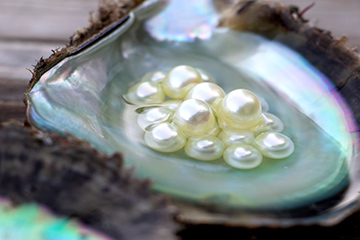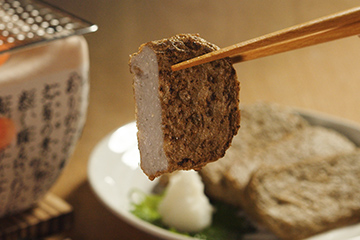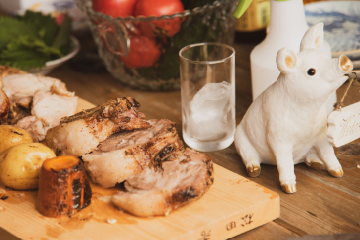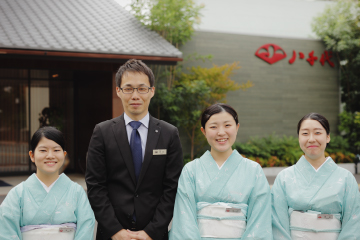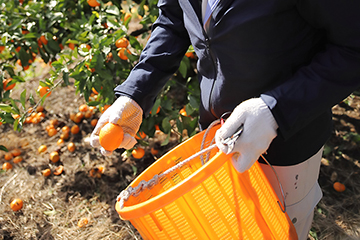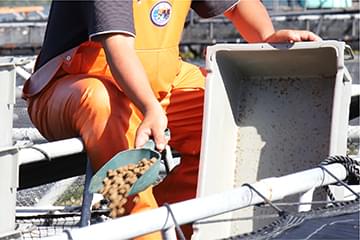「Ehime Amatoro Buta (Pig)」
The secret of the branded pigs that keeps increasing the number of shipments.
Among the more than 300 types of brand-name pork in Japan, one popular pig is enjoying steady growth in shipments. This is the “Ehime Amatoro Buta (Pig)”, a brand pig created in 2009. As the name suggests, it melts in your mouth and is said to be good for your beauty and health. The ideal quality of the meat, which seems to be a combination of the “best parts” of pork, is the result of the wisdom, skills and love of skilled pig farmers who raise the animals with the full support of the prefecture.

Melts in the mouth. Soft yet firm texture. Juicy flavor.
“You can taste three different tastes in one bite,” says Mr. Hiroshi Matsuda of Matsuda Pork Farming (Ozu City), who was the first person to raise “amatoro” pig. The sweet and fragrant fat that melts on the tongue, the high quality lean meat with a soft texture packed like marble, and the juicy flavor that overflows as you bite into it. Surprisingly, all three tastes have been scientifically proven to be delicious. “The melting point of fat for melt-in-the-mouth, shear strength for tenderness, and water retention for juiciness are all quantified,” Matsuda says. Another reason why the meat is highly supported by women is that it is rich in oleic acid, which is said to be good for beauty and health, at 43.5 percent (compared to 34.6 percent for ordinary pigs).

“A day in the life of a seven-month-old ‘amatoro’ pig means a month or more to us,” says Mr. Matsuda, explaining why he carefully monitors the pigs’ health every morning and evening. He puts a lot of love and care into raising the pigs, even naming the sows that give birth to the “amatoro” pigs.

Matsuda Pig Farm is located in a mountainous area at an altitude of 400 meters above sea level, and is called the “Pig Farm in the Sky”. In a remote environment surrounded by fresh mountain air and clean water, the pigs are raised “slowly, slowly, and firmly”.

The breed, descended from a visionary pig, is slowly fattened up with bare barley from Ehime Prefecture.
They say that the taste of pork is determined by half the breed and half the feed. By adopting a method of raising pigs of less fattening breeds with less fattening food, the sweet and tender meat of the pork becomes beautifully crisp and firm. “The father ‘amatoro’ pig is a Middle Yorkshire breed, of which there are only 500 in Japan. It used to be the mainstream in Japan, but due to their poor fattening, they have disappeared from the market and are now a rare breed,” says Mr. Matsuda. The barley grown in Ehime Prefecture is fed to the Amazumi Pork, which has inherited the genes of such a rare breed of pig. The healthy ingredient, which is richer in calcium than brown rice and contains more than 10 times as much dietary fiber as white rice, slowly nurtures the high quality meat of the ama-trot pork.

They have a lovely appearance with a stocky body and a tea-tube nose. Shipped within 180 to 240 days, when the flesh is at its best.

Ehime Prefecture is the largest producer of barley in Japan. By feeding plenty of safe and nutritious original feed at the right time before shipping, the pork is made into delicious, soft-tasting pork.

Raised in a stress-free environment, making sure to take care of the smallest details.
“Because it takes about 1.2 times as long to raise ‘amatoro’ pigs as ordinary pigs, it’s important to create a stress-free environment,” says Mr. Yutaka Shiba of Shiba Pig Farming (Seiyo City), who was so impressed by the delicious taste of ”amatoro” pigs that he started raising them. He feeds the pigs, which are usually numbering 800 to 900, natural water drawn from a water source deep in Ryuzawaji Green Park, which is selected as one of the 100 best forests in Japan, and keeps the pigs in a spacious environment that avoids dense rearing. Mr. Shiba, who has been raising pigs for many years, checks the pigs’ breathing every morning and evening when he feeds them. He reads the slight changes in their breathing to determine their health conditions, and the pigs are made to meet the strict standards set by the Ehime Commission for the Promotion of Sugar Bowl Pigs.

The plant is equipped with a feces and urine circulation system to prevent infection and the environment. Part of the manure is used to compost “the fastest-harvesting Baron potatoes in Japan,” which are grown in Uwajima City’s Mizunaiura district.

“We feed our sows special feed rich in iron and vitamins and minerals so that they can produce strong, stable pork,” says Mr. Shiba,

“We reflect meat quality data in our breeding methods and continue to deliver consistent, delicious food.”
“I’m happy to say that most of the customers who have taste-tested our products have purchased them,” Mr. Shiba says, recalling the memories of a tasting event he attended at a department store. The reason why the meat quality is so consistent is the reason why even restaurants that are particular about the taste of the meat keep coming back. Five pig farmers scattered throughout Ehime Prefecture meet several times a year to share information. Based on the meat quality data quantified by the Livestock Research Center of Ehime Prefecture, they adjust the amount of feed used and work hard to constantly improve the quality of their products.

A beautiful sculpture of sweet pork adorns the Matsuda Pig Farm. The sculptor who created this sculpture was also fascinated by the deliciousness of “amatoro” pork.

The sweet and tender pork was created over a period of five years at the Livestock Research Center through repeated tests of sensory perception (taste) and body growth (fattening).

Tel: 089-912-2560
Fax: 089-912-2561

Tel: 089-912-2560
Fax: 089-912-2561







